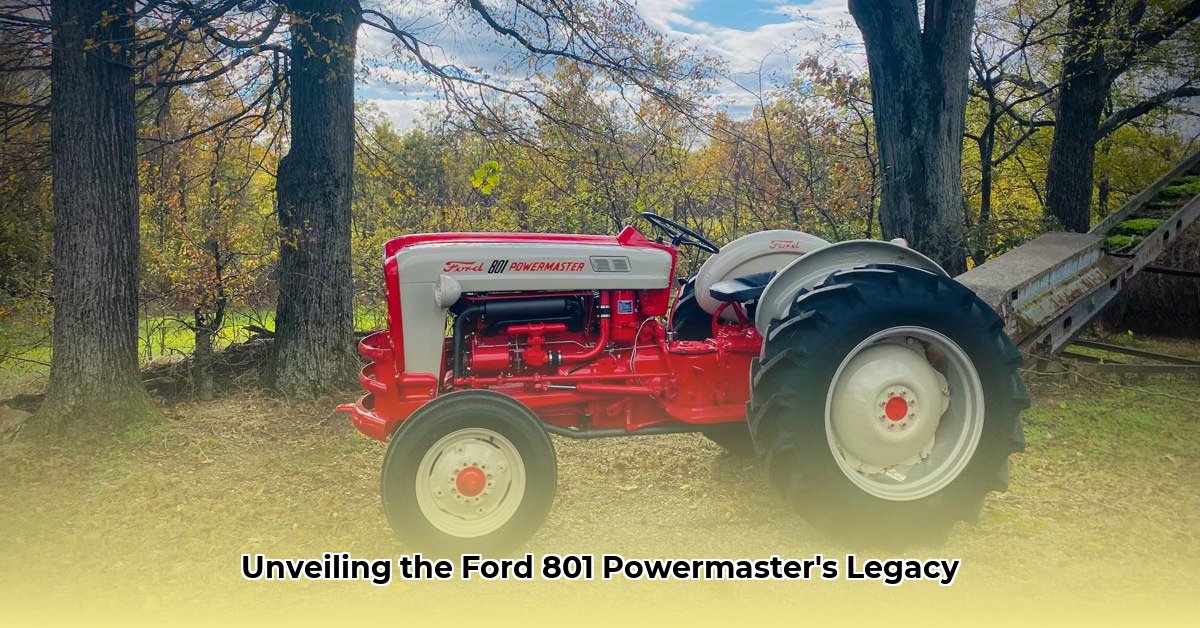
The Ford 801 Powermaster, alongside its sibling the 861, represents a pivotal moment in agricultural history. Emerging in the late 1950s, these tractors embodied the mechanization revolution transforming farming practices. This article delves into the 801's design, performance, impact, and enduring legacy, exploring both its celebrated strengths and often-overlooked challenges. For more Ford tractor history, see this detailed resource.
The Heart of the 801: Engine and Performance
Both the 801 and 861 boasted a robust 2.8-liter engine offering a choice of gasoline, liquid petroleum gas (LPG), or diesel fuel. This flexibility, a significant advantage in a time of varied fuel availability and costs, showcased the tractor's adaptability. While horsepower figures vary slightly across sources (approximately 60-65 hp), these tractors consistently demonstrated the power to pull three 14-inch plows – a considerable workload for the time. This variability in reported horsepower likely stems from variations across production years and optional equipment configurations. Further investigation is needed to definitively resolve the discrepancy. Was this fuel flexibility a key factor in the 801's market success?
Behind the Wheel: Design and Features
The 801 Powermaster’s design, while groundbreaking for its era, presents a fascinating blend of innovation and limitations. Its five-speed, non-synchronized transmission, a common feature of tractors of the time, demanded a skilled touch and more physical effort than modern synchronized transmissions. The open operator station provided excellent visibility but offered minimal protection from the elements. Fuel and hydraulic fluid tank capacities were modest, reflecting the typical workload and workday lengths of the period. Yet, the tractor’s renowned durability – with parts still available today – highlights its robust construction.
More Than a Machine: Impact on Farming Practices
The Ford 801 Powermaster's impact extended beyond the mechanics of increased productivity. Increased speed and efficiency led to higher yields and improved farm economics. This machine also standardized certain farming techniques, leading to greater consistency and efficiency across operations. The 801's influence resonated throughout the agricultural landscape, contributing to a more streamlined and effective farming process.
A Lasting Impression: Legacy and Continued Appeal
Though subsequent models incorporated advancements in fuel efficiency, operator comfort, and safety features, the Ford 801 Powermaster maintains its position as a symbol of agricultural innovation. Its reliability and fuel flexibility remain key elements of its lasting appeal. Today, many meticulously restored 801s stand as a testament to this machine's enduring quality. Its presence in agricultural museums and many private collections ensures its place in history.
Cousin Comparison: 801 vs. 861 Powermaster
A direct comparison between the 801 and 861 highlights their shared strengths and subtle variations:
| Feature | Ford 801 Powermaster | Ford 861 Powermaster | Notes |
|---|---|---|---|
| Engine | 2.8L (Gas, LPG, Diesel) | 2.8L (Gas, LPG, Diesel) | Fuel choice depended on local availability. |
| Horsepower | ~63.7 hp | ~62.6 hp | Reported horsepower varies across sources. |
| Transmission | 5-speed, non-synchronized | 5-speed, non-synchronized | A common feature for tractors of that era. |
| PTO Power | Varied | Varied | PTO (Power Take-Off) power varied by engine and configuration. |
| Drawbar Pull | Varied | Varied | Drawbar pull depended on engine and conditions. |
| Operator Station | Open | Open | Limited protection from weather. |
The Ongoing Story: Future Research Avenues
To fully understand the Ford 801 Powermaster's impact, further research is crucial. Analyzing sales figures and gathering firsthand accounts from farmers who operated these tractors will yield invaluable insights. Comparative analysis of its performance against contemporary tractors will provide context, and assessing its long-term environmental impact, considering its fuel options, offers a valuable modern perspective.
Restoring a Ford 801 Powermaster Engine: A Guide
Restoring a Ford 801 engine is a rewarding but involved undertaking. Proper fluid maintenance is paramount. However, conflicting online reports highlight the importance of consulting original service manuals for accurate fluid capacities.
Essential Fluids and Their Capacities
Inconsistent online data regarding fluid capacities underscore the need for reliable sources. An original service manual is essential to avoid potentially damaging mistakes.
| Fluid Type | Capacity (quarts) | Notes |
|---|---|---|
| Engine Oil | 5-6 | Varies by source; consult your manual |
| Transmission Oil | 6.5-10 | Significant variation reported online |
| Differential Oil | 8-11.5 | Consult service manual for accurate measurement |
| Hydraulic Fluid | 6-9 | UTF (Universal Tractor Fluid) often suggested; check for leaks between compartments |
Conquering the Fuel System
Airlocks in the fuel system frequently plague restorations. Bleeding the Roosa Master fuel pump is essential.
Restoring a Ford 801 Engine: A Step-by-Step Guide
- Disassembly: Meticulous disassembly and documentation (photos and notes) are crucial for successful reassembly.
- Cleaning: Thorough cleaning of all components using appropriate solvents is essential.
- Inspection: Careful inspection for wear and tear, replacing damaged components. The service manual is indispensable here.
- Rebuilding: Reassembly, precisely following documented steps and adhering to torque specifications.
- Testing: Thorough engine testing to check for leaks, proper oil pressure and performance. This step is crucial to ensure a successful restoration.
This restoration process requires significant mechanical skills. Seeking expert assistance for challenging steps is highly recommended.
The Rewards and Challenges of Restoration
Pros:
- Significant sense of accomplishment.
- Increased tractor value.
- Improved performance and reliability.
Cons:
- Time-intensive project.
- Potentially high costs (parts and tools).
- Requires considerable mechanical expertise.